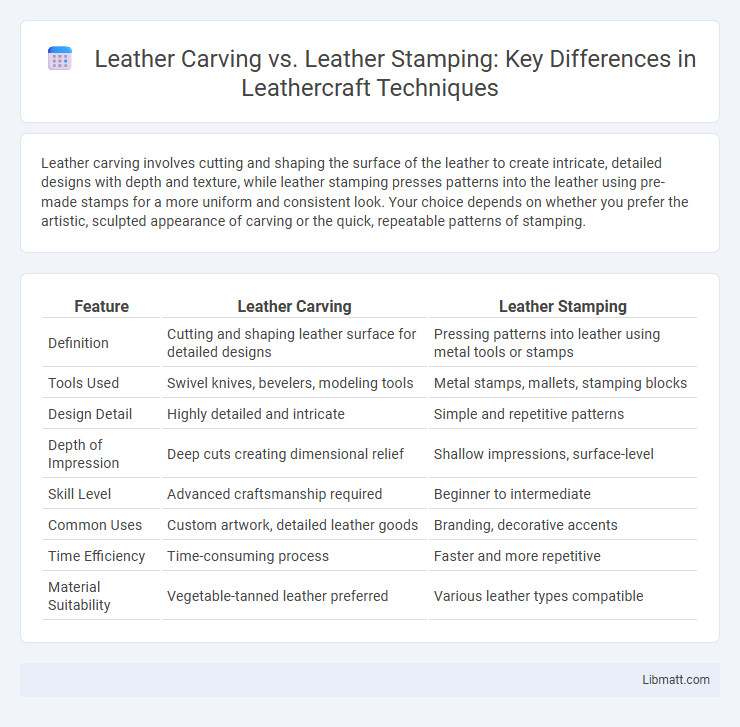Leather carving involves cutting and shaping the surface of the leather to create intricate, detailed designs with depth and texture, while leather stamping presses patterns into the leather using pre-made stamps for a more uniform and consistent look. Your choice depends on whether you prefer the artistic, sculpted appearance of carving or the quick, repeatable patterns of stamping.
Table of Comparison
| Feature | Leather Carving | Leather Stamping |
|---|---|---|
| Definition | Cutting and shaping leather surface for detailed designs | Pressing patterns into leather using metal tools or stamps |
| Tools Used | Swivel knives, bevelers, modeling tools | Metal stamps, mallets, stamping blocks |
| Design Detail | Highly detailed and intricate | Simple and repetitive patterns |
| Depth of Impression | Deep cuts creating dimensional relief | Shallow impressions, surface-level |
| Skill Level | Advanced craftsmanship required | Beginner to intermediate |
| Common Uses | Custom artwork, detailed leather goods | Branding, decorative accents |
| Time Efficiency | Time-consuming process | Faster and more repetitive |
| Material Suitability | Vegetable-tanned leather preferred | Various leather types compatible |
Introduction to Leather Carving and Stamping
Leather carving involves hand-cutting intricate designs into the leather surface using swivel knives, allowing for detailed, three-dimensional patterns that bring texture and depth. Leather stamping uses metal stamps and mallets to imprint repetitive patterns or shapes, creating uniform designs more quickly and efficiently. Your choice between carving and stamping depends on the desired level of detail and the specific artistic effect you want to achieve on leather projects.
Defining Leather Carving
Leather carving involves cutting and shaping the leather surface to create intricate, three-dimensional designs with depth and texture, using specialized swivel knives and tools. This technique allows for detailed patterns and artistic expressions by making precise incisions that can be further enhanced with beveling and shading. Unlike leather stamping, which relies on pressing pre-made metal stamps into the leather to create repetitive impressions, leather carving emphasizes handcrafted, unique artwork.
Understanding Leather Stamping
Leather stamping involves pressing pre-made metal stamps into the leather surface to create consistent, repetitive designs quickly and efficiently. This technique enhances your leatherwork with intricate patterns or logos without extensive hand-tooling skills, making it ideal for beginners or mass production. Unlike leather carving, which requires cutting and shaping, stamping relies on embossing to create decorative textures.
Tools Required for Each Technique
Leather carving requires specialized tools such as swivel knives for precise cuts and various bevelers, pear shaders, and backgrounders to create depth and texture. Leather stamping utilizes metal stamps, mallets, and sometimes stamping presses to imprint repetitive designs and patterns onto the leather surface. Both techniques demand a cutting mat or cushion beneath the leather to protect surfaces and ensure clean impressions.
Materials Suitable for Carving vs Stamping
Leather carving requires vegetable-tanned leather due to its firm, pliable surface that holds detailed impressions well, making it ideal for intricate designs. Leather stamping works best on chrome-tanned or other softer leathers, which respond to repeated pressure without cracking, allowing for bold, consistent patterns. You should select the appropriate leather type based on the technique to ensure durability and the precision of your finished piece.
Step-by-Step Process Comparison
Leather carving involves carefully cutting and molding designs into the surface using swivel knives and bevelers, creating intricate, three-dimensional patterns. Leather stamping presses pre-made metal stamps into the leather with a hammer or press, producing repeated patterns quickly and efficiently. Your choice depends on whether you prefer detailed, hand-crafted artistry or faster, consistent decorative impressions.
Artistic Possibilities and Design Flexibility
Leather carving offers intricate, three-dimensional designs with deep cuts and shading, allowing for detailed, customized artwork that showcases fine craftsmanship. In contrast, leather stamping provides consistent, repetitive patterns ideal for bold, textured designs but with more limited variation and depth. Your choice depends on whether you prioritize unique, detailed artistry or uniform, time-efficient embellishments.
Durability and Longevity of Finished Products
Leather carving offers deeper, more detailed impressions that enhance the durability and longevity of your finished products by resisting surface wear and fading. Leather stamping creates shallower designs that may wear down faster over time due to frequent friction and exposure. Choosing carving ensures a robust, long-lasting aesthetic that withstands daily use.
Common Applications and Project Ideas
Leather carving is commonly used for detailed, intricate designs on belts, wallets, and saddles, allowing artisans to create personalized floral or geometric patterns with depth and texture. Leather stamping is ideal for repetitive patterns and logos on items like keychains, coasters, and bracelets, providing consistent, quick designs through metal stamps. Both techniques are popular in crafting custom leather goods, with carving suited for artistic, one-of-a-kind projects and stamping excelling in branding and uniform decoration.
Choosing the Right Technique for Your Leathercraft
Leather carving offers intricate, three-dimensional designs by cutting and shaping the leather surface with specialized tools, ideal for detailed, artistic projects requiring depth and texture. Leather stamping uses pre-made metal stamps to impress patterns quickly and consistently, making it suitable for repetitive or simpler designs with uniform impressions. Selecting the right technique depends on the desired complexity, project scale, and the specific aesthetic effect needed for your leathercraft.
Leather carving vs leather stamping Infographic

 libmatt.com
libmatt.com